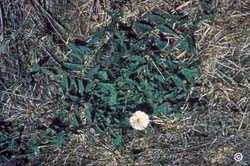What are noxious weeds?
Aliens have invaded the Colorado landscape! These aliens are in the form of non-native weeds called “noxious” in Colorado. They’ve gotten that name because of their invasiveness, aggressiveness and the rate at which they spread. Noxious weeds are difficult to control, and most are very adaptable. They also can withstand a variety of harsh conditions, including climate extremes, drought and poor soils. There are approximately 1 million acres of noxious weeds in Colorado. The weeds cost Colorado residents more than $10 million annually in lost productivity. Noxious weeds often displace native plants. Many native species have been forced out of their natural habitat.
What types of noxious weeds are there?

There are several noxious weeds in Colorado. Among the worst are leafy spurge, spotted knapweed, diffuse knapweed, Russian knapweed, Canada thistle, musk thistle, Dalmatian toadflax, yellow toadflax, field bindweed and purple loosestrife. Noxious weeds in Colorado have been divided into three categories:
- List A weeds – elimination mandatory throughout Colorado.
- List B weeds – plants whose continued spread should be stopped.
- List C weeds – selected for recommended control methods.
How can I control noxious weeds?
Weed management includes cultural practices such as: avoiding overgrazing re-vegetating disturbed soils, and maintaining the vigor of desirable grasses or other plants that compete with weeds. The easiest time to control noxious weeds is when only a few plants are present. Mowing weeds before their seeds are mature will help prevent the seeds from spreading and will reduce weed vigor.
Is biological control effective for noxious weeds?
Biological control can involve using livestock such as sheep and goats to graze on weeds, which reduces their vigor. It also may involve introducing a specific disease or insect to affect weeds. Biological control has proven to be effective to varying degrees on some weeds. Planting desirable plants to outcompete the weeds can also be effective.
Herbicides may be used on noxious weeds as part of an integrated control strategy, often in combination with cultural and biological controls.
For more information, see the following Colorado State University Extension fact sheet(s).
- Weed Management for Small Rural Acreages
- Musk Thistle
- Range and Pasture Weed Management
- Leafy Spurge
- Diffuse and Spotted Knapweed
- Russian Knapweed



